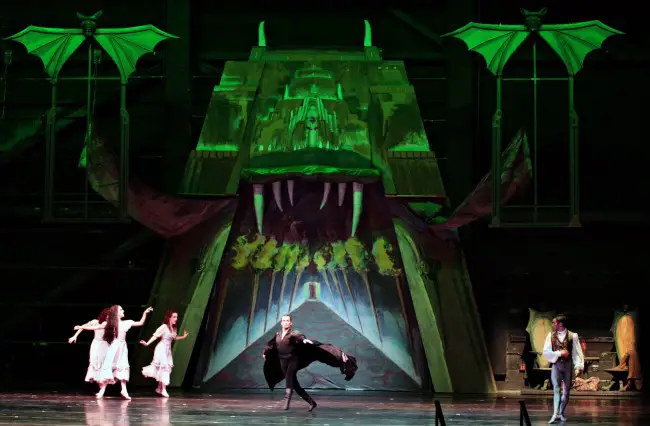
Ballet isn’t usually the first thing you think about at the mention of Dracula’s name. Fangs, yes. Blood-sucking from dishy white necks, yes. Stakes through the heart and made-up Transylvanian accents, too. But pointe work and pirouettes? Not so much.
Kim Tuttle’s point in her choreography of “Dracula,” performed Oct. 30 by Gainesville’s Dance Alive National Ballet at the Flagler Auditorium, is that Dracula is an adaptable sort of guy. A swinger on many levels. He has multiple wives. He dances. He suspends disbelief and toys with it—with you, that is, his captive audience. Almost two decades ago Tuttle got the idea of setting Dracula to dance from University of Florida Symphony Orchestra conductor Raymond Chobaz, who had a friend interested in composing a ballet version. The idea gelled over time, and the ballet was first performed in 1992.
The result, Diana Mumbauer, Dancer Magazine, “is an exciting combination of dance, music, narration, and setting which transforms a boring novel into a vivid, multi-sensory experience. Ms. Tuttle has long since transcended mere prettiness, and characters which might be nothing but filler in other works are so well conceived as dancer that they enrich the ballet.”
And why not? A few years ago no one would have imagined that teen-age sighs, stares and eye-rolling could fill a 2,000-page, multi-volume epic and rival the Bible in book sales. But there you have it: Stephenie Meyer’s “Twilight” series has given the vampire genre a whole new lease on chic, compulsively chaste though the Twilight boppers insist on being.
Dracula of course is the dean—or founding freak—of vampires. Bram Stoker, a one-hit wonder Irish novelist whose day jobs as the business manager of a theater in London and a newspaper writer paid the bills, wrote the book in 1897, possibly under the original title of “The Undead.” He hit stardom in Europe. The book was first serialized in American publications. The New York Times took notice on Sept. 2, 1899, when it described the book as “an exceedingly dramatic story of a human vampire” in a one-paragraph preview of the book’s American publication “in a day or two.”
The rest is his story: the curtain tonight goes up on Count Dracula’s Transylvanian castle (in there Romania’s way), where a lawyer makes his way from London on the pretext of an entirely improbable real estate transaction (hence the immediate relevance to Palm Coast audiences). The lawyer is beguiled by Dracula’s courtesy but soon discovers that he’s trapped, and that the castle is a little shop of horrors animated by Dracula’s vampire brides. The story goes from there to London where there’s a good deal of chasing after fiancées (the luscious Lucy primarily, who gets more marriage proposals in one day than an American tourist in Morocco), suspicious (and oddly AIDS-like) deaths and the emergence of the goodly Professor Abraham Van Hessling, who goes medieval on Dracula’s fangs all the way back to Transylvania. It’s no spoiler to mention Dracula’s entirely biblical homage to death by dust: like the Rocky Horror Picture show, it’s not about the plot. It’s about the experience.
Picture all that set to dance, with Andre Valladon in the lead role and Michele Incollingo as Lucy, Rostislav Dzabraev as the lawyer Jonathan Harker, and Reka Gyulai as his Mina.
Picture yourself at intermission too: there’ll be a costume contest involving the audience—with prizes—and children under 12 get in free.
![]()
Dance Alive National Ballet’s production of “Dracula” (Saturday, Oct. 30) at 7 p.m. at the Flagler Auditorium. Tickets are $18 for adults, youth (12-18) $9, and children under 12 get in free. You can reserve tickets by calling 386/437-7547.
Dracula: A Photo Gallery
[nggallery id=38]




























Leave a Reply